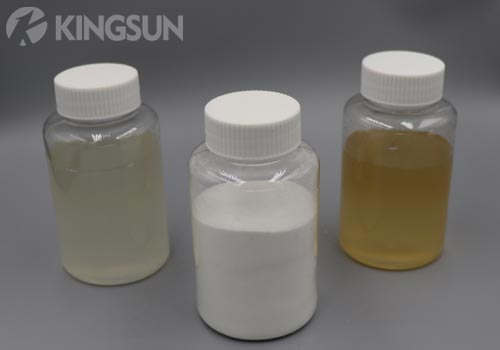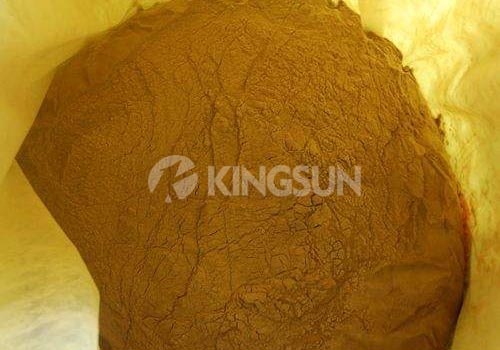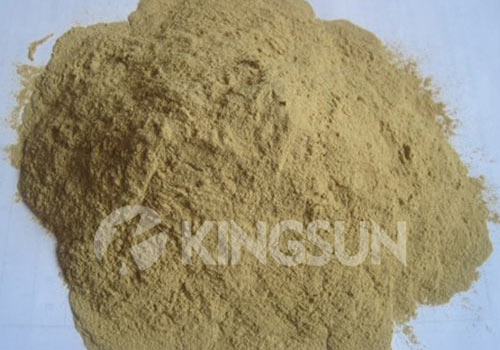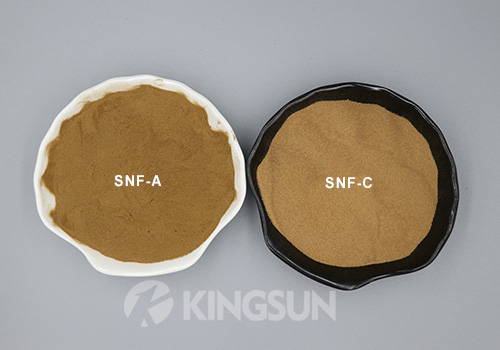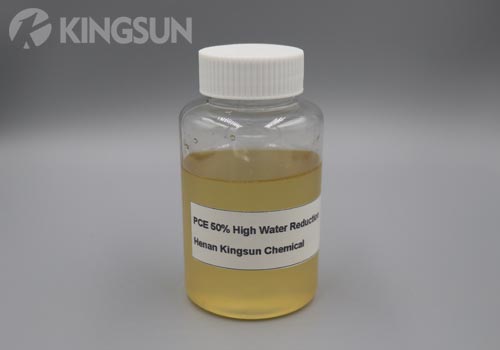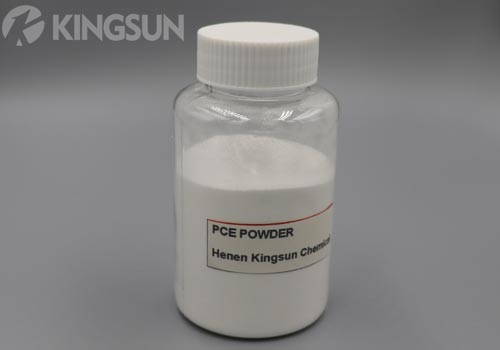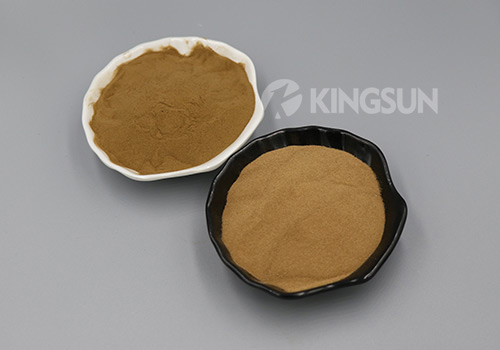Water reducing admixture, also known as plasticizer, is designed to enhance the workability of concrete without increasing its water content. By dispersing cement particles more effectively, these admixtures allow for a reduction in water content while maintaining the desired slump. This results in improved strength, reduced permeability, and enhanced durability. Kingsun water reducing admixtures are particularly useful in high-strength concrete, where maintaining the right balance of water and workability is crucial.
Different Types of Water Reducing Admixtures in Concrete
We already know that the main purpose of using water reducing agent is to reduce the amount of water, increase the strength of concrete, improve the workability of concrete. According to the different water-reducing ability, water reducing admixture in concrete can be divided into two categories, they are ordinary water reducing admixtures and high-performance superplasticizers. Among them, both sodium lignosulfonate (SLS) and calcium lignosulfonate (CLS) belong to ordinary water reducing admixtures. While naphthalene sulfonate superplasticizer and polycarboxylate superplasticizer (PCE) belong to superplasticizers. However, for different series of water reducers, their functions, prices and costs are also different. By the way, as a leading concrete admixtures manufacturer and supplier in China, Kingsun always provides high quality products, competitive prices and good services for all the clients. And the following are the detailed introduction of these water reducing admixtures in concrete:
- Sodium Lignosulphonate
- Calcium Lignosulfonate
- Naphthalene Superplasticizer
- Polycarboxylate Superplasticizer
Sodium lignosulphonate is a ordinary water reducing admixture for concrete and its raw material is lignin. This product is yellow-brown, free-flowing powder, easily soluble in water, chemically stable, and will not decompose in long-term sealed storage. Lignin series products are a kind of surfactant, which can produce multiple products through modification, processing, compounding and other methods. So it is mainly used as concrete water reducing agent, printing and dyeing diffusing agent, oil field drilling mud dispersing agent, etc.
Sodium Lignosulphonate Uses in Concrete
- Reduce water consumption and increase the strength of cement.
- Improve the workability and fluidity of the concrete while maintaining the same amount of water and strength.
- Reduce the amount of cement used and the amount of water used to maintain the same strength.
- Can be compounded into retarder, early strength agent, pumping agent, antifreeze, etc.
| Items | Sodium Lignosulfonate |
| Appearance | Yellow Brown Powder |
| Dry Matter % | 92 min |
| Lignosulphonate % | 60 min |
| Moisture % | 7 max |
| Water-insoluble matter % | 0.5 max |
| Sulfate (as Na2SO4) % | 4 max |
| PH Value | 7.5-10.5 |
| Content of Ca and Mg % | 0.4 max |
| Total reducing matter % | 4 max |
| Content of Fe % | 0.1 max |
| Packing | Net 25kg PP bags; 550kg jumbo bags; |
Calcium lignosulfonate is mainly used as a ordinary concrete water reducer. It has the functions of adsorbing and dispersing cement, and improving various physical properties of concrete. The following are its main features:
- Without changing the water consumption of the concrete, the fluidity of the concrete can be increased, the workability can be improved, and the project quality can be improved.
- The dosage is 0.20-0.30% of the cement dosage, and the usual dosage is 0.25%, which can reduce the water consumption by 8-12%.
- While keeping the concrete slump and strength the same as the reference concrete, 8-10% of cement consumption can be saved.
- It can improve the impermeability and freeze-thaw performance of concrete, and is non-corrosive to steel bars and aggregates.
| Index items | Standard value | Test Results |
| Appearance | Brown powder | Meets the requirement |
| Moisture | ≤5.0% | 3.2 |
| PH value | 8–10 | 8.2 |
| Dry matter | ≥92% | 95 |
| lignosulphonate | ≥50% | 56 |
| Inorganic salts(Na2SO4 | ≤5.0% | 2.3 |
| Total reducing matter | ≤6.0% | 4.7 |
| Water insoluble matter | ≤4.0% | 3.67 |
| Calcium magnesium general quantity | ≤1.0% | 0.78 |
Sodium naphthalene (SNF) belongs to the second generation of high range superplasticizer. It is a product of naphthalene sulfonation by sulfuric acid and condensation with formaldehyde and is an anionic surfactant. The appearance is light brown powder. It is easily soluble in water and has a good dispersion effect on many powder materials such as cement. And the water reduction rate of naphthalene superplasticizer can reach 25 percent.
Features of Naphthalene Superplasticizer
- When the strength and slump are basically the same, the amount of cement can reduce by 10% to 25%.
- When the water-cement ratio is constant, the initial slump of concrete can increase by more than ten centimeters, and the water reduction rate can reach 15% to 25 percent.
- It has a significant early strength and enhancement effect, and its strength can increase by 20-60%.
- It can improve the workability of concrete, adapt to various types of cement. Moreover, it is compatible with other types of concrete admixtures.
- Particularly suitable for use in the following concrete works: fluid concrete, plasticized concrete, steamed concrete, impervious concrete, waterproof concrete, natural curing precast concrete, steel and prestressed reinforced concrete, high strength ultra high strength concrete.
| Type | SNF-A | SNF-B | SNF-C |
| Solid Content (%) ≥ | 92% | ||
| PH Value | 7-9 | ||
| Na2SO4 Content (%)≤ | 5 | 10 | 18 |
| Chlorine Content (%)≤ | 0.3 | 0.4 | 0.5 |
| Net Starch Fluidity(mm)≥ | 250 | 240 | 230 |
| Water Reducing Rate(%) | 26 | 25 | 23 |
| Packing | 25kg pp bag; 650kg Jumbo bag. A customized package is available. | ||
Polycarboxylate based superplasticizer (PCE) is the latest third-generation high efficiency superplasticizer. It has best application prospect and comprehensive performance. Compared with the performance of similar products at home and abroad, PCE superplasticizer has good technical performance index, application prospect and comprehensive performance.
PCE is an ideal concrete admixture with unique performance and no pollution, and it mainly exists in the form of powder and liquid. Moreover, polycarboxylate superplasticizers have many advantages in performance and production, such as high water reduction rate with a low dosage, the loss is small when the slump is light, less impact on cement setting time, good adaptability to cement.
| Items | Standard | ||||
| PCE (High Water Reduction) | PCE (High Slump Retention) | PCE Powder | |||
| Appearance | Light Yellow Liquid | Clear Transparent Liquid | White Powder | ||
| Solid Content, % | 50±1.0 | 50±1.0 | 98±1.0 | ||
| Density (23℃) (kg/m3) | 1.13±0.02 | 1.05-1.10 | 600±50 | ||
| PH | 6.5-8.5 | 6.5-8.5 | 9.0±1.0 | ||
| Chloride Content,% ≤ | 0.1 | 0.1 | 0.1 | ||
| Na2SO4 (by solid content), % ≤ | 4.0 | 4.0 | 4.0 | ||
| Solubility | Completely Soluble | ||||
| Water reducing ratio, % ≥ | 25 | ||||
| Packing | 230kg PE drum, 1100kg IBC tank or flexitank, 25 kg PP woven bag. | ||||
The Main Advantages of Water Reducing Agents for Concrete Construction
- Improved Workability. Concrete water reducing agents enhance the flow and workability of concrete, making it easier to place, compact, and finish. This allows for better consolidation and reduces the effort required during construction.
- Increased Strength. By reducing the water content in the concrete mixture, Kingsun concrete water reducing admixtures improve the cement-to-water ratio. This results in higher strength development, leading to stronger and more durable concrete structures.
- Enhanced Durability. The use of water reducing admixture improves the overall durability of concrete. It reduces the permeability of the concrete, making it less susceptible to moisture ingress, chemical attacks, and freeze-thaw damage.
- Reduced Shrinkage and Cracking. Water reducing agents help mitigate drying shrinkage in concrete, minimizing the risk of cracking and deformation. This is particularly important in large concrete pours or structures with restrained conditions.
- Increased Workability Retention. They can extend the workability or slump retention time of concrete, allowing for easier transportation and placement of concrete over longer distances or timeframes.
- Improved Cohesion and Segregation Resistance. These admixtures enhance the cohesion between cement particles, reducing the tendency for segregation and bleeding in fresh concrete. This leads to a more uniform and homogenous mixture.
- Compatibility with Other Admixtures. Kingsun water reducing agent can be used in conjunction with other admixtures, such as air-entraining agents, retarders, accelerators, and more. This allows for customization of concrete properties to meet specific project requirements.
- Environmental Benefits. The use of water reducing admixture enables the production of concrete with lower water content, resulting in reduced water consumption during construction. This can contribute to water conservation efforts and minimize environmental impact.
- Cost Savings. The water reducing admixture can help reduce the cement content in concrete mixtures while maintaining the desired workability and strength. This leads to cost savings in terms of raw materials, transportation, and overall construction expenses.
- Improved Construction Efficiency. With better workability, reduced shrinkage, and increased strength, water reducing admixtures contribute to improved construction efficiency. They enable faster and smoother construction processes, leading to time and labor savings.
Based on the different water reduction effects, Kingsun concrete water reducing admixtures can be divided into High-efficiency superplasticizer, ordinary concrete water reducer, air-entraining superplasticizer, Retarding superplasticizer and early strength superplasticizer.
- High-efficiency water reducer, also known as superplasticizer, such as PCE superplasticizer, naphthalene sulfonate water reducer, etc., It means that under the premise of the same slump of concrete, the addition of high-efficiency water reducer can reduce the concrete The effect of water enhancement, compared with ordinary water reducing admixtures, the performance of high-efficiency water-reducing agents is significantly improved. High-efficiency water-reducing agents have a wide range of applications, such as prefabricated Concrete, prestressed reinforced concrete, cast-in-place reinforced concrete, etc. For early-strength concrete, large-flow concrete, and steam-cured precast concrete components, it is also suitable for high-strength concrete, medium-strength concrete, and ultra-high-strength concrete. In addition, the high-efficiency water reducer can also be used as the water reducing component of the concrete admixture.
- Ordinary concrete water reducer, under the premise of the same concrete slump, is widely used as a general admixture (such as lignosulfonate water reducer) for various reinforced concrete, cast-in-place concrete, pre-cast Stress concrete, prefabricated (without oxygen steaming process) concrete and medium and low-strength concrete, as well as mass concrete, hot weather construction concrete, pumped concrete and concrete with mild retarding requirements. It is also widely used in formwork construction and slip form construction, especially in concrete construction where the daily minimum temperature is above +5°C.
- Air-entraining superplasticizer, an admixture with air-entraining and water-reducing effects, air-entraining superplasticizer is mainly used in antifreeze concrete, winter construction concrete, roller compacted concrete and lightweight concrete.
- Retarding superplasticizer is an admixture with dual functions of retarding and water reducing. It is suitable for large-volume concrete, concrete with daily minimum temperature above +5°C or concrete in high-temperature areas, pumped concrete and slip-form construction, etc.
- Early strength superplasticizer. The superplasticizer has an admixture for improving early strength and water reducing functions. The early strength superplasticizer is suitable for construction operations in steamed oxygen concrete and normal temperature, low temperature and negative temperature (the lowest temperature is not lower than -5°C), and has Early strength or concrete projects with antifreeze requirements.
As a concrete admixture, water reducing admixture is widely studied and used at present. Adding an appropriate amount of water reducing agent to the concrete, the water reducing agent is adsorbed on the cement particles during the mixing process of the concrete, so that the same kind of charge is generated between the cement particles, and then mutually repelled, thus forming dispersed cement particles. The cement particles in the concrete are dispersed under the action of adding the water reducer, which reduces the formation of cement flocs in the concrete and reduces the amount of mixing water. With the continuous increase of free water in concrete, the fluidity of cement slurry is continuously increased. By adding an appropriate amount (0.2% to 1.5%) of water reducing agent in concrete, the performance of concrete can be changed:
- By adding an appropriate amount of water-reducing agent into the concrete, the water consumption of the concrete under the same conditions can be reduced by 5% to 25% under the premise that the workability of the concrete remains unchanged, thereby improving the strength of the concrete.
- Under the condition of the same concrete water-cement ratio, by adding a proper amount of water reducer to the concrete, the concrete slump can be increased by 10cm to 20cm, which meets the operation requirements of concrete in large formwork construction and lifting slab construction.
- Under the condition of the same strength of concrete, by adding an appropriate amount of water reducer to the concrete, the water consumption of concrete under the same condition can be reduced by 5% to 20%.
- It can be used as the main raw material for the production of performance cement. By adding concrete water reducer with different properties into concrete, retarded high-strength concrete, high-strength concrete, and ultra-high-strength concrete can be produced. The use of water-reducing agents to produce performance concrete is simple, flexible and economical.
- In the process of adding water reducing agent, we should strictly control the water consumption of concrete according to the design requirements of water reducing rate.
- Add an appropriate amount of water reducing agent according to the ratio requirements, and control the weighing error within ±5%.
- After the concrete is mixed with water and stirred for 1-2 minutes, then add the water reducer. If a liquid water reducer is used, it must be ensured that the mixing time with the concrete is at least 1 minute; if a solid water reducer is used, it must be stirred for at least 1.5 minutes.
- If the water reducing agent is an air-entraining water reducing admixture, in order to ensure that the compactness of the concrete meets the design requirements, it is necessary to strengthen the vibration to remove air bubbles after the concrete is formed.
- After the concrete is mixed with water reducing admixture, the interval time should be controlled within 1 hour from the time the mixer is discharged to the stage when the concrete is molded.
- The mixing ratio design scheme of ordinary concrete is used to determine the amount of superplasticizer added. If water reducing agent is added in order to reduce the amount of cement, it is necessary to add sand and gravel with the same volume as the saved cement amount to make up for it.
Buy High Quality Water Reducing Admixture from Kingsun
Do you know where to buy high quality water reducing admixtures for concrete? Choosing the right concrete water reducing admixture manufacturers & suppliers are very critical for us. The following reasons explain why you should choose Kingsun?
- As the most professional manufacturer in China, Kingsun has more than 15 years’ experience in construction chemicals industry.
- Kingsun has its own factory and advanced production lines, so we can provide customers with sufficient supplies and competitive prices.
- All of our chemical products have passed strict quality inspections and certifications, such as ISO 9001, SGS, etc.
- At present, Kingsun water reducing admixtures have been exported to more than 30 countries, they are Malaysia, Singapore, Pakistan, Bangladesh, Bahrain, Mexico, Chile, Israel, Qatar, Brazil, Turkey, Saudi Arabia, UAE, South Africa, Jordan, Peru, South Korea, Indonesia, Thailand, Philippines, Vietnam, Russia, India, etc. Welcome to cooperate with us!

